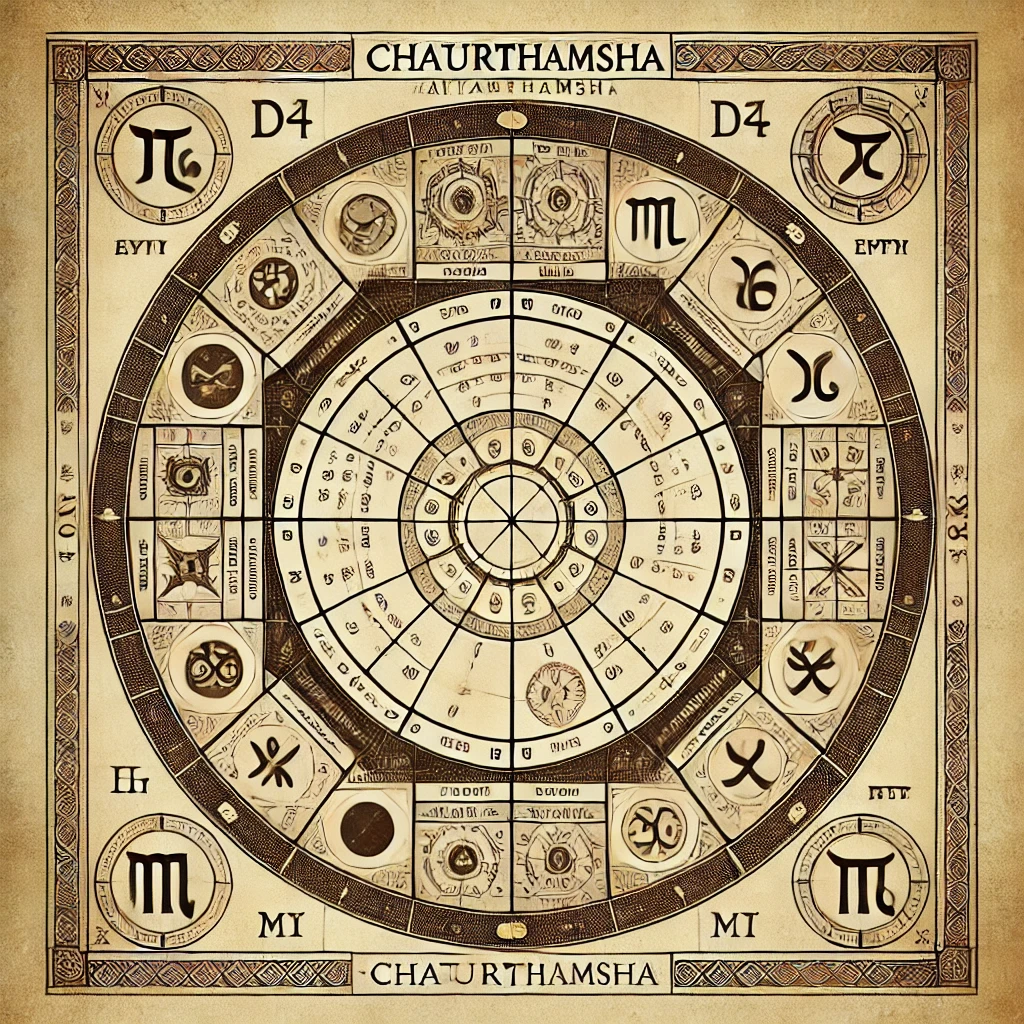Understanding Chaturthamsa Chart in Vedic Astrology
In Vedic astrology, divisional charts, known as Vargas or Amshas, play a crucial role in providing a deeper and more detailed analysis of various aspects of an individual’s life. One such important divisional chart is the Chaturthamsa Chart, also referred to as the D4 chart. This chart is specifically used to analyze matters related to property, residence, and overall happiness in life. Let’s delve into the intricacies of the Chaturthamsa Chart, its significance, and how it is interpreted in Vedic astrology.
What is the Chaturthamsa Chart?
The Chaturthamsa Chart is derived by dividing each sign of the zodiac into four equal parts of 7.5 degrees each. This results in a total of 48 sections (4 parts for each of the 12 signs). The placement of planets in these sections reveals detailed information about a person’s assets, property, and living conditions. The D4 chart provides insights that the main birth chart (Rasi chart) may not fully capture, offering a more nuanced view of property-related matters.
Importance of the Chaturthamsa Chart
- Property and Real Estate: The primary focus of the Chaturthamsa Chart is on property and real estate. It helps in understanding the acquisition, maintenance, and loss of property. This includes homes, land, and other real estate investments.
- Residential Comfort: The D4 chart provides insights into the quality of residence and living conditions. It indicates the level of comfort and happiness one might experience in their home environment.
- Family Happiness: The chart also sheds light on familial happiness and relationships within the household. It can reveal potential conflicts or harmony among family members.
- Material Comforts: Apart from real estate, the Chaturthamsa Chart indicates the material comforts and luxuries an individual might enjoy in their life.
Calculation of the Chaturthamsa Chart
The Chaturthamsa Chart is calculated by dividing each sign of the zodiac into four parts, each spanning 7.5 degrees. The placement of planets in these divisions determines their influence in the D4 chart. Here’s a simplified version of the calculation process:
- Division of Signs: Each sign (30 degrees) is divided into four parts, each of 7.5 degrees.
- Allocation of Planets: Based on the degrees of the planets in the Rasi chart, they are allocated to the corresponding divisions in the D4 chart.
- Interpretation: The placement of planets in the Chaturthamsa Chart is then interpreted to understand their influence on property and related matters.
Key Houses in the Chaturthamsa Chart
- 4th House: The 4th house in the Chaturthamsa Chart is of utmost importance as it represents home, property, and general happiness. It indicates the quality of one’s residence and the comfort derived from it.
- 1st House (Ascendant): The ascendant or the 1st house represents the overall outlook towards property and residence. It also signifies the individual’s efforts and attitude towards acquiring and maintaining property.
- 10th House: The 10th house indicates success in real estate investments and the overall gains from property-related activities. It also represents the profession and career related to real estate.
- 8th House: The 8th house can reveal potential obstacles, inheritances, and sudden gains or losses related to property.
Interpretation Techniques
- Planetary Placement: The placement of planets in the Chaturthamsa Chart is crucial. Benefic planets (like Jupiter and Venus) in favorable houses can indicate positive outcomes related to property. Malefic planets (like Saturn and Mars) may signify challenges.
- Aspect and Conjunctions: The aspects and conjunctions of planets in the D4 chart provide additional layers of interpretation. Beneficial aspects can enhance positive outcomes, while challenging aspects may indicate difficulties.
- Strength of Houses: The strength and dignity of the key houses (4th, 1st, 10th, and 8th) play a significant role in determining the overall influence of the chart. Strong and well-placed houses generally lead to favorable results.
Practical Applications
- Real Estate Investments: Individuals can use the Chaturthamsa Chart to make informed decisions about real estate investments. It provides insights into the best times to buy or sell property and potential gains or losses.
- Home Renovations: The chart can guide decisions related to home renovations and improvements, ensuring that changes enhance comfort and happiness.
- Resolving Property Disputes: The D4 chart can help in understanding and resolving property disputes, identifying potential solutions and outcomes.
- Family Harmony: By analyzing the chart, individuals can gain insights into family dynamics and take steps to enhance harmony and happiness within the household.
Case Studies
To illustrate the practical application of the Chaturthamsa Chart, let’s consider a few hypothetical case studies:
- Successful Real Estate Investor: An individual with a strong 10th house and benefic planets in the 4th and 10th houses in the Chaturthamsa Chart is likely to experience success in real estate investments. This person’s chart might show multiple profitable property deals and a comfortable living environment.
- Challenges in Property Acquisition: A person with malefic planets in the 4th house and an afflicted ascendant in the D4 chart may face obstacles in acquiring property. This could manifest as delays, financial difficulties, or legal issues.
- Inherited Property: If the 8th house in the Chaturthamsa Chart is strong and influenced by benefic planets, the individual may inherit property. This person’s chart might show sudden gains through ancestral assets.
Conclusion
The Chaturthamsa Chart (D4 chart) is an essential tool in Vedic astrology for understanding property-related matters, residential comfort, and overall happiness. By analyzing the placement of planets, key houses, and aspects in the D4 chart, astrologers can provide valuable insights and guidance to individuals. Whether it’s making informed real estate decisions, resolving property disputes, or enhancing family harmony, the Chaturthamsa Chart offers a comprehensive view of the various aspects of life related to property and residence.

Comments
One response to “Chathurthamsa Chart”